Early Adulthood
By 1345 the losses in the fields of war were balanced by the gains of the strong Florentine economy fueled by its strong currency and the profits of the big money lenders. That changed when some of the biggest clients of the Florentine bankers, like the King of England and the King of France proved to be unreliable.
The bankruptcy of the greatest players of the Florentine banking system (Peruzzi & Bardi) dragged with it the whole Florentine economy. The vicious circle would close in the worst possible way with the outbreak of the Black Death in 1348.
More than half of the city’s population perished, thousands left the city to avoid infection and mass graves piled with hundreds of Florentinessurroundingd its walls. The calamity would be recorded by the Florentine Giovanni Boccaccio, one of the most important writers and poets in Italian history, and harbinger of the Renaissance that was about to follow.



With the economy waning and the shortage of labor after the plague creating a shortage in food, tensions between the lower classes and people who had moved in from the countryside after the plague on one side and the upper-middle classes also known as the fat people PopolooGrassoo) that ruled the city started to increase.
In 1355 an estimated 22% of the households in Florence lived in extreme poverty. The internal disputes were briefly put aside when the Pisani, under the command of an ingenious English condottiere (professional mercenary) named John Hawkwood started to encroach upon Florentine territory and occupied a series of towns. In the Battle of Cascina, just a few miles from Pisa, in July 1364, the Florentine army triumphed and the city’s supremacy was effectively defended.


A victory against a rival city could only mean one thing for the Florentines at the time. That they could go on with their internal strife undisturbed. The Arti Minori, or minor guilds, were constantly in contention with the Arti Maggiori, or the seven major guilds.
After the plague a new class of main immigrants with no aristocratic background known as the genteNuovaa bonded with the people of the minor guilds that had no saying in the city government, against the oligarchy of the major guilds that controlled the Guelph party.
When Florence turned against Avignon’s Pope Gregory XI, due to his attempt to expand the Papal States as a prerequisite for his return to Rome and the fact that John Hawkwood, was raiding Tuscany to extract payment from his employer, who was none other than the pope, the expenses of the government skyrocketed. Firstly to pay off Hawkwood and his men, secondly to pay for an increase of its military force that was depleted after the plague, and finally to finance a coalition against the new Papal claims.
In the War of the Eight Saints that followed between Florence and the Avignon Pop,e the battles were mostly conducted in the diplomatic field. Florence incited revolts in the cities of the papal state while Pope Gregory XI excommunicated all members of the Florentine government and placed the city under interdict in March 1376. Despite the confiscations of the ecclesiastical property by the Signoria, the detriment in Florence’s economic life was substantial mainly due to the economic sanctions imposed on Florentine merchants living abroad.


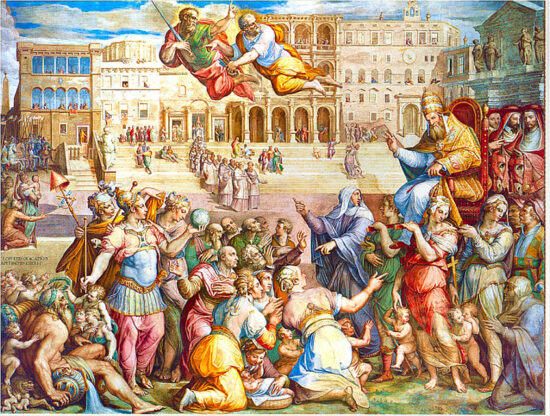
The heavy burden of the taxes used to finance the state’s policy would cause the first documented proletariat revolt in history, the so-called Ciompi revolt in 1378. Fourteen minor guilds spearheaded by below-wages textile workers managed to seize government power by force and hold it until 1382.
The cause for the collapse of the proletariat government was once again internal disputes, this time between wool merchants and dyers. When the Florentine elites took back the power they initially tried to soften up their relationship with the laboring class by reforming the tax system but the rebellion awakened a fear that could not go away easily.
The constant paranoia of the nobles about the next moves of the working class led to a more authoritative and autocratic government, a structure more centralized for decisions to be made promptly in case of imminent danger. That would open the way for the oligarchic government of the Albizzi family (rich wool merchants and leaders of the black Guelphs that had been exiled during the government of the Ciompi) that held power for almost 50 years (1382 – 1434).



Towards the end of the 14th century,y the Duchy of Milan ruled by the powerful family of the Visconti had reached its apogee. The project of Gian Galeazzo Visconti (Milanese ruler between 1385 and 1402) was to unify Italy under a large national state with Milan at the head, similar to what was happening at that time in France or Spain. The only state that was able to stand up to his army was Florence under the guidance of John Hawkwood who had jumped to the Florentine camp by 1380.



The effete Republic of Pisa became part of the Milanese dominion in 1399. Three years later and after a great victory against the joint Bolognese-Florentine army, Galeazzo Visconti died of the plague. His widow found it more useful to sell Pisa to the Florentines who wanted complete control of the route to the sea.
The Pisani who had a long line of battles with the Florentines were not willing to accept the decision hands down. After a long siege, Pisa was finally conquered by the Florentines in 1406: the Florentines managed to corrupt the Capitano del Popolo (People’s Captain) Giovanni Gambacorta who opened the city gates of the besieged city.
With the rivalry with Milan being temporarily frozen, Florence was once again free to embark on its expanding expeditions in mainland Italy. At the same time,e a new generation of artists, starting with Lorenzo Ghiberti ( 1378 – Florence, 1455) Filippo Brunelleschi ( Florence 1377 – 1446) and Donatello (Florence, 1386 – 1466) took over major works like the astounding doors of the Baptistery, the statues of Orsanmichele external niches and the key features of Santa Maria del Fiore like the great dome and the almond door, which were commissioned by the major arts. These works inaugurated a period in human history that would be identified by many historians with the city of Florence, that of the Renaissance.



By the1420ss the Albizzi family had led the republican government for almost two generations. Despite the progress in both domestic and Italian affairs,s the Fiorentini had grown weary of their one-dimensional inclination towards war, which bled the city in both men and money.
The situation favored the rise of a more moderate, pacifist leadership. Lorenzo & Cosimo Medici had taken over their father’s bank in 1420, a financial network with branches in Rome, Venice,e, and Genoa. Both brothers had been tutored by one of the earliest figures of the Renaissance, a humanist and a poet who later became chancellor of the Republic named Carlo Marsuppini.
Cosimo Medici took what was an Italian business centered mainly on Papal finances and transformed it into a European bank with branches in Bruge, Pari, Londo,n and the rest of the major cities of Europe in just a few years, without ever striding away from Church’s affairs.



Although Cosimo’s wealth had secured him a great extent of influence in the city’s politics, he preferred to pull the strings on the background without ever claiming a public office. When the city decided to conquer the Republic of Lucca in 1429 and Cosimo stepped up as the funding manager of the expedition, the Albizzi who controlled the government together with the Strozzi started to feel threatened.
In September 1433 Cosimo of the Medici was imprisoned, accused of conspiring against his dictatorship. He managed to save his life and turn his sentence into exile instead of execution. By taking his bank with him to Padua and then Venice, Cosimo managed to set the foundations of his triumphant return from the start.
Less than a year after his exile Cosimo’s supporters in Florence managed to overturn the sentence and bring Cosimo back by democratic means. RinaldoDeglii Albizzi and his family were banished from the cityendg once and for all an oligarchic regime that had stood for more than 50 years.
Although in a position to impose a one-man rule, Cosimo decided to keep all democratic bodies and instigate a series of constitutional changes that would secure his power through influence. Typically he was just a citizen, but in reality,y he was the one who decided the names of candidates for the municipal offices, in essence,e a king in all but name.


Cosimo would immediately prove to be an enlightened leader whose intellect and love of knowledge could propel Florence into a new era. In 1437 his deal with the leading scholar and collector Niccolò Niccoli would make him the heir of the latter’s invaluable collection of ancient Greco-Roman manuscripts, the basis of the new public library at San Marco that would be financed by Cosimo a few years later, the Biblioteca Medicea Laurenziana.
In 1439, after a series of generous donations, he managed to convince Pope Eugenio IV, who had already been living in Florencesincem 1434 due to a revolt in Rome, to move the Great Ecumenical Council that would try to reconcile the Byzantine Orthodox Church with Roman Catholicism, from the city of Ferrara to Florence.
The council skyrocketed Cosimo’s and Florence’s international prestige and sparked the imagination of ordinary people and of the Florentine artists who were astounded by the colorful and bizarre characters from the East, the outlandish clothes of the Orthodox delegates and the grandeur of the Byzantine Emperor John VIII Palaeologus who was also in Florence.

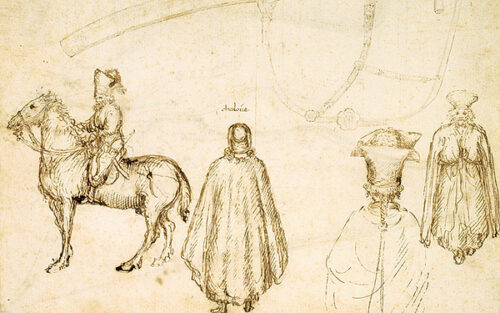
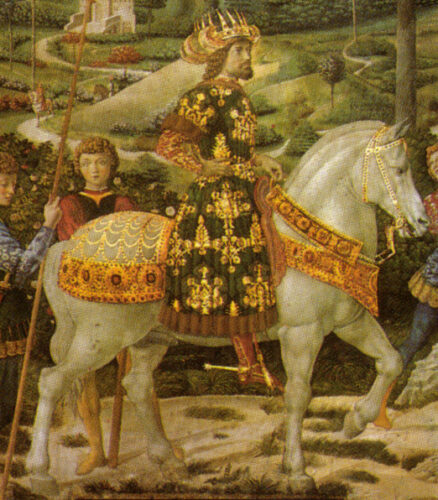
The economy of the city benefited as well from an event of universal importance like that, while it probably gave vent to Cosimo’s vision of turning Florence into a new Athen. An extraordinary interest in Platonic philosophy and Greek literature would stay on, long after the Greeks’ departure.
In 1440 the Duke of Milan, Filippo Maria Visconti, would try to follow up on his father’s dream of a united Italian kingdom under the rule of Milan. Prompted by the pleas of Rinaldo degli Albizzi who had been living in Milan after his exile and was trying for a long to make the Milanese ruler intervene and restore him to power in Florence, Visconti ordered the advancement of his army in Tuscany. The Florentine victory in the Battle of Anghiari would put a bridle on Milanese expansionism, securing Florentine domination of central Italy for the next 50 years.
Freed from the greatest external threat and already dominant in internal affairs Cosimo continued to offer to his city all the things that could make it stand out on a European level, with even more fervor. A true bibliophile who did not hesitate to embark on any undertaking that involved books himself, he finances the construction of the first public library of Florence in 1444.
The Biblioteca Medicea Laurenziana would be attached to the cloister of San Lorenzo already revamped by Michelozzo and Donatello and paid for by Cosimo. The reconstruction of the Convent of San Marco, the renovation of Badia Fiesolana, and the construction of Palazzo Mediciwase was also works carried out during Cosimo’s era.


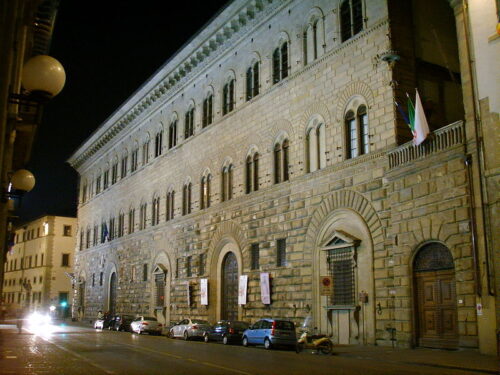
The death of Filippo Maria Visconti in 1447 brought forth a new alliance between Milan and Florence that joined forces to tackle the constantly rising power of the Republic of Venice. The Peace of Lodi in 1454 stabilized the fragile balance between the three powers as well as Naples, bringing precious perception to the Italian peninsula after centuries of constant warfare.
When Cosimo died in 1464 he was buried according to his wishes as a private citizen. The Florentines acknowledging his immense contribution to the city’s betterment declared him Pater Patriae, father of the Florentine nation, a titlinscribed based on his posthumous statue now located at the Loggia of the PalazzoDeglii Uffizi.



Cosimo’s death was enough for a new round of unrest to kick in. Luca Pitti, a loyal friend and servant to Cosimo during his rule, a nobleman and a banker that served as head magistrate of Florence and ruled Florence during the last years of Cosimo’s government was heavily indebted to the Medici Bank.
In August 1466 he tried to seize power with the help of troops sent to Florence by the Duke of Ferrara. Cosimo’s son Piero managed to hold on to power with the help of the Florentine people. A new attempt for a coup this time backed by Venice would also fail. As soon as internal turmoil seemed to be appeased the Venetian army invaded the Florentine territory (1467).
In the Battle of Molinella in July 1467, the joint army of the Florentines and the Milanese together with some troops sent by the King of Aragon and the ruler of Bologna managed to stop the Venetian advancement.
Upon Piero’s death in 1469, his oldest son Lorenzo, raised as a true golden boy assumed power at the age of twenty. Lorenzo’s grandfather and father had been the greatest art patrons and collectors in Florence’s history up to that point, while his mother was also an educated noblewoman, lover of poetry and philosophy, writer & poet herself. Tutored by diplomats and humanists, neo-platonic philosophers with deep knowledge of ancient Greek writings, Lorenzo would soon surpass his ancestors in greatness.



Aside from his Renaissance upbringing, Lorenzo had the amazing luck to rule Florence in a time when three mythic figures of art, Sandro Botticelli (born in 1445 in Florence), Leonardo da Vinci (born in 1452 in Vinci just outside modern-day Florence) and Michelangelo (also a Florentine, born in 1475).
Lorenzo surrounded himself with the enlightened Florentine teachers who became his entourage and gave way to these artists to unfold their immense talent during their very early steps. Michelangelo in particular lived with Lorenzo and his family for five years, dining at the family table whilst at the same time he attended the Neoplatonic academy that Cosimo Medici had founded after the Council of Florence (1439).



In 1478 the Medici edifice was shaken by a conspiracy plotted by the families of Pazzi and Salviati (Noble Florentine families that served as Papal Bankers) in close alliance with Pope Sixtus IV with a plan to assassinate both Lorenzo de’ Medici and his brother Giuliano and replace them with Sixtus IV’s nephew, Girolamo Riario.
The two Medici brothers were attacked on Easter Sunday in the Cathedral of Santa Maria del Fiore before a crowd of 10.000 Florentines. Giuliano was stabbed 19 times by Bernardo Bandi and Francesco de’ Pazzi and bled to death on the cathedral floor, but Lorenzo managed to escape with a wound to the shoulder.
The coup failed before it began and most of the conspirators were soon caught and executed; five, including Francesco de’ Pazzi and Salviati, were hanged from the windows of the Palazzo Vecchio. Jacopo de’ Pazzi, head of the family, escaped from Florence but was caught and brought back. He was tortured, then hanged from the Palazzo Vecchio next to the decomposing corpse of Salviati. The Pazzi were banished from Florencforeverer, all records of them, coats of arms, any trace of them was erased forever.


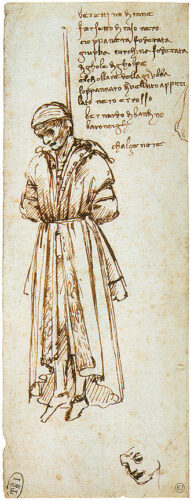
The pope was infuriated with the fiasco of the rebellion. The execution of the Archbishop of Pisa, Francesco Salviati, in his ceremonial robes would give him all the needed excuse for a full frontal attack against Lorenzo. All Medici assets in papal lands were confiscated and Lorenzo along with the members of his government was excommunicated. Soon after a papal delegation was sent to Florence to arrest Lorenzo and the rest of the perpetrators.
When the people refused to abide the whole state was put under interdict, and Mass and communion were forbidden. The papal wrath did not subside. Sixtus went on with the formation of a military alliance with the Kingdom of Naples and the Republic of Siena. The son of the King of Naples, Alfonso Duke of Calabria led an invasion of the Florentine Republic in June 1478.
With no support from Bologna and Milan, the Florentine castles fell one after another. The war dragged on for two years before Lorenzo’s ingenuity ultimately resolved the conflict in 1480, assisted by the Turkish invasion in Southern Italy of that year.



The Turkish threat operated as an agent of unification for the Italian rulers, but not the pope. Disappointed by the failure of his Tuscan ambitions and unswayed by the conquest of Otranto by the Turks Papa Sisto lured the Serenissima (Republic of Venice) for an attack against Ferrara in 1482.
Lorenzo’s actions secured Ferrara’s independence despite its defeat. After his iinterventionLorenzo was hailed as the leading figure of Italian politics by compatriots, Italian ll words foreign leaders alike. From then on he would be Lorenzo il Magnifico (Lorenzo the Magnificent).
With the death of Pope Sisto IV in August 1484 and the ascension of Pope Innocent VIII on the throne, a dangerous enemy and a disturber of Italian peace were taken out of the picture and Lorenzo cemented an alliance between the Papal states, Naples and Florence that would help all three and Italy as a whole. Lorenzo’s unexpected death in the Spring of 1492, at the age of 43, due to gangrene, left most Florentines in a state of shock.
He was buried without a pump, according to his wishes in the Basilica of San Marco. Decades later his remains were moved to the New Sacristy of the Basilica of San Lorenzo in a monumental tomb sculpted by his close friend Michelangelo. He had managed to achieve greatness during his lifetime, to be the main agent of the Renaissance splendor of Ital,y and to be attributed among others for the rebirth of the city of Pisa.



Although Lorenzo had turned Florence into the cultural capital of the Italian peninsula he also made a grave mistake during his later years. He had introduced a Dominican friar from Ferrara named Girolamo Savonarola to Florence, which would sink the city into a retrograde mist of religious bigotry. Lorenzo had invited Savonarola soon after he had secured the independence of his city, impressed by the friar’s oratory skills.
Although his first stay did not cause much turbulence, it was clear from the start that his deeply theocratic view of reality was not in tune with a secularized a great extent society like the Florentine. He soon left Florence for Lombardy but in 1490 he was summoned again by Lorenzo.
When Savonarola resumed his preaching in San Marco in 1490 it immediately became apparent that his speeches were more aggressive. He had become more of a radical whose sermon reminded the fanatics of the early Middle Ages. The main recipient of his scourging lectures, the degenerate Church and Lorenzo of the Medici himself, corrupter of true Christian customs, steered Florentine society into pagan, frivolous pleasures.
After Lorenzo’s death and after just two years at the helm, his son Piero was faced with an invasion by King Charles VIII of France who claimed the throne of the Kingdom of Naples. When Piero attempted to mount a resistance, he received little support from Florentine elites, who had already fallen under the influence of Girolamo Savonarola; even his cousins defected to Charles’s side. Piero’s failure to negotiate good terms for the surrender of his city put an end to his family’s rule. The Florentines revolted, the palazzo of the Medici was looted and his family was exiled.



Savonarola took advantage of the power vacuum and led a delegation to the camp of the French King. After a short occupation and a huge subsidy from the city, the French resumed their journey to the south. Savonarola who had previously prophesied that God’s wrath would soon fall upon the sinners, now declared his prophecies came true with the French King acting as the hand of God and that Florence was spared because its population had answered his call to penitence.
A new political party, the Savonarola Frateschi (the friar party) was formed and soon Savonarola’s priorities became the official state policy through the city councils. A new more democratic constitution gave all citizens the right to vote and tried to curb the consolidated practice of exiles. From the pulpit of the Cathedral of Santa Maria del Fior,e the new Florentine leader declared a new era of universal peace. Savonarola’s peace was not as inclusive as it was declared to be.
With most of the simple people of the low classes (the weepers his critics called them) by his side, his government started to enforce a series of measures for the purging of the city from all of its vices. New laws were passed against sodomy, adultery, public drunkenness,s and all kinds of moral transgressions. Secular art was labeled as damaging and worthless. New founded patrols of young men scoured the streets for sinners or indecent outfits.
A bit to the south, the man sitting on the papal throne since 1492 was not famous for his piety. On the contrary,y Pope Alexander VI remains to this day one of the most infamous Popes for exactly the opposite reason. More famous today by his family name, Rodrigo Borgia, tolerated the whims of the Florentine fanatic until Savonarola declined the papal proposition for the formation of a Holy League against the French invaders. When the Florentine friar refused to appear before him in Rome, the Pope accused him of heresy and false prophecies and banned him from preaching.



After a brief interval, Savonarola continued his preaching that became more hateful than ever. His fears of a papal conspiracy made him suspicious of all Florentines that did not comply fully with his view of a theocratic society.
His verbal attacks on secret enemies became more violent, special masses for the youth and religious theaters were organized, often processions and bonfires of the vanities where thousands of objects such as cosmetics, art (including works by Botticelli, and books were set ablaze. Savonarola had turned the Renaissance capital of the world into a Dark-ages nightmare.
In May 1497 Girolamo Savonarola was excommunicated and the Florentines were warned of an imminent interdict if they continued to support him. In March 1498, Savonarola stopped preaching. A failed attempt to win over the crowds again with a miracle that never happened was enough for the crowds to feel fed up.
In May 1498 the risen Medici party had him arrested along with two of his close associates. He was tried for heresy, tortured until he confessed,d and burned at the stake in the middle of the PizzaDellaa Signoria. His ashes were scattered in the Arno so that his followers don’t have the chance to look for his relics.




